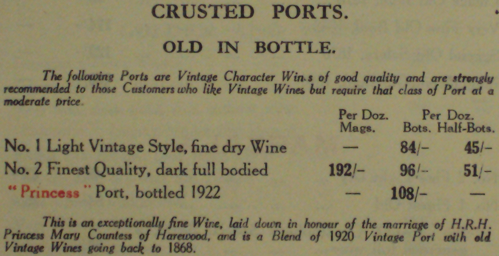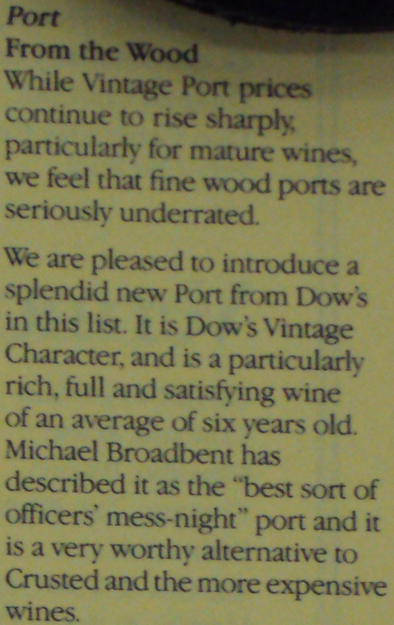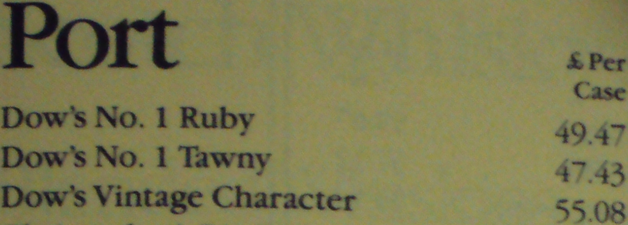
Prices are £ per case and per bottle.


Are the Croft and Taylor more likely to be LBVs rather than Crusteds? I can't think of another explanation for two dates on the bottle.jdaw1 wrote:Winter 1966/1967, from Edwin Giddings Ltd, then of 28 St John Street, Devizes, now of 15 St John Street
No, no, no. How could they possibly be LBV when it wasn't "invented" until Noval released their 1958 and then "invented" again by Taylor when the released their 1965? Not wishing to single out these two houses, there seems to have been lots of others who "invented" LBV at various timesJacobH wrote:Are the Croft and Taylor more likely to be LBVs rather than Crusteds? I can't think of another explanation for two dates on the bottle.jdaw1 wrote:Winter 1966/1967, from Edwin Giddings Ltd, then of 28 St John Street, Devizes, now of 15 St John Street
These comments beg another question: when was the expression ‟late bottled vintage” first used? Doing a quick search of the Usual Free Sources, I can’t find any mention before André Simon’s Vintagewise where he comments (in 1945):DRT wrote:No, no, no. How could they possibly be LBV when it wasn't "invented" until Noval released their 1958 and then "invented" again by Taylor when the released their 1965? Not wishing to single out these two houses, there seems to have been lots of others who "invented" LBV at various timesJacobH wrote:Are the Croft and Taylor more likely to be LBVs rather than Crusteds? I can't think of another explanation for two dates on the bottle.
I agree, these are LBVs. But the term wasn't in common useage at the time so it probably made more sense to describe them as Crusted.








Without wishing to get into a debate over semantics, I think one needs to draw a distinction between a vintage port that happened to be bottled late, and a port that was deliberately marketed as Late Bottled Vintage.These comments beg another question: when was the expression ‟late bottled vintage” first used?

That's not a bad test to apply, Tom, and Julian and I are on the lookout for other examples. Something I think is worth adding to the criteria as being what we now term LBV is that the wine should have been Oporto bottled - i.e. designed and produced as LBV by the shipper, not turned into LBV by a merchant.uncle tom wrote:The test, I would suggest, is the use of the term in a merchant's catalogue, and as far as I know, the Wine Society holds the distinction of using the term first in 1964 for a Fonseca Q. Mileu 1958, also bottled in 1964.
I can see your reasoning; but if the Mileu '58 (which was English bottled) was shipped shortly before bottling, and had not languished, forgotton, in the WS's warehouse for a few years (thereby making the LB element merely expedient), I would suggest that it qualifies.Something I think is worth adding to the criteria as being what we now term LBV is that the wine should have been Oporto bottled
Oh, yes, indeed. What I was interested in was something slightly different; when was the phrase ‟late bottled vintage port” first coined, rather than when the product it describes came about. There is no particular reason why a vintage port bottled 4 years after a harvest should be called a ‟late bottled vintage” any more than it should be called ‟cellar reserve” or anything else; so someone must have coined the phrase at some stage, and I wonder if that was André Simon. For an interesting comparison, using the same free sources produces references to ‟crusted port” from as far back as 1799, but the earliest use of the expression ‟vintage port” seems to be from the 1850s...uncle tom wrote:Without wishing to get into a debate over semantics, I think one needs to draw a distinction between a vintage port that happened to be bottled late, and a port that was deliberately marketed as Late Bottled Vintage.
The test, I would suggest, is the use of the term in a merchant's catalogue, and as far as I know, the Wine Society holds the distinction of using the term first in 1964 for a Fonseca Q. Mileu 1958, also bottled in 1964.













The ‟Princess” Port is quite interesting; we usually assume that a Crusted Port is made out of youngish vintages to produce (as the catalogues frequently say) a cheaper form of Vintage Port. But there is no reason why they could not, instead, make a premium version with older vintages, to produce a ruby version of an aged and blended tawny Port...jdaw1 wrote:Christopher & Co. Ltd, Xmas 1930.





George Hill Ltd Price List wrote:Churchill's Crusted - bottled 2000/01 (2 years blended together, then bottled)


This is a bottle that is for sale in the US right now, a store has it for $100. I've been sent pictures which are clearly stated "Late Bottle Vintage" on the original label. I've thought about getting one just for curiosity, but at that price I keep spending the money on other older VP's that are a better bet*uncle tom wrote:The references to the Fonseca/Guimaraens Q. Mileu '58 in the Christopher catalogues are intriguing..
.
Is this a UK (Wine Society) bottling, or an Oporto bottling?which are clearly stated "Late Bottle Vintage" on the original label
And it has an embarrassingly prominent spelling error on the label.Andy Velebil wrote:Opps, darn memory wasn't spot on yesterday, it says "Late Bottled 1964" and it's from Avery's.
That makes it a Vintage Port. I wonder why Dirk chose not to have it approved and released as a VP?uncle tom wrote:From what dirk said the other night, I think the Niepoort 2005 previously recorded was 2005 juice bottled in 2007, so one and the same.



This is Colheita, not Crusted.jdaw1 wrote:The Army & Navy Co-operative Society, March 1908:
Yes, but as the thread had expanded into a discussion of the inventor of LBV, I thought that this modest further expansion might be of interest.DRT wrote:This is Colheita, not Crusted.
I think at the time it would have been known as a 'Refreshed Tawny' - the permitted term today for a 40yr+ tawny blend is 'Very Old Tawny'This is Colheita, not Crusted